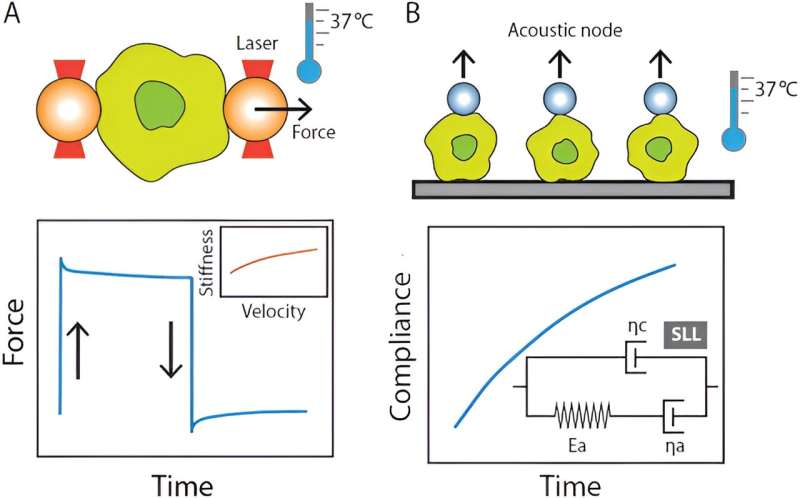This article has been reviewed according to Science X's editorial process and policies. Editors have highlighted the following attributes while ensuring the content's credibility:
fact-checked
trusted source
proofread
Stiffness and viscosity of cells found to differ in cancer and other diseases

During illness, the stiffness or viscosity of cells can change. Tom Evers demonstrated this by measuring such properties of human immune cells for the first time. "The stiffness of certain cells could be a way to make a diagnosis," Evers said.
He received his PhD on 26 March for the thesis "Single-cell mechanics for disease biology and pharmacology." A resulting article was published by Materials Advances.
Within a tumor, cells grow close together in tissue where they do not belong. Therefore, there's more pressure from packed cells. Cells react to this by reinforcing their structure, just as our bones become stronger when subjected to more stress.
The stiffness of cells likely also plays a role in leaky blood vessels. Blood vessel cells may become less rigid or even somewhat fluid. Viruses like Ebola are deadly due to hemorrhagic fever, where blood vessels begin to leak. Evers has succeeded in measuring the stiffness of cells.
As a student of Biomedical sciences, Evers found biophysics so interesting that he was willing to go to Siberia for it. "It was sometimes -40 degrees in Tomsk, but I also experienced +40." He had a great time there in 2016/17, when he completed the first half of his double master's degree. The other half was biomedical in nature, back in his hometown of Maastricht. "In Leiden, I could combine both fields."
A macrophage must be able to deform
Evers could express his adventurous side well in Alireza Mashaghi's lab at LACDR. "We study the mechanical properties of cells—their stiffness and viscosity. These are extremely important in, among other things, the immune response to disease." For example, a macrophage that engulfs a pathogen must be able to deform around it smoothly.
These mechanical properties also play a role in cancer. "In a tumor, some cells become softer, less rigid. These cells can more easily migrate through the body, which happens in metastatic cancer."
In leukemia, where monocytic immune cells are affected, their mechanical properties change. "If we can measure that accurately, the stiffness of such cells could be a way to diagnose the disease." Cell stiffness then becomes a so-called biomarker.
Evers worked with optical tweezers, among other tools. With this device, scientists can, for example, hold a strand of DNA, pull on it, and then measure how tightly it is wound. "I modified the tweezers so that you can sandwich a cell between two glass beads. By pushing the beads together with a certain force and observing the stretch the cell undergoes, we determine the stiffness of the cell."
Near tumors, something strange happens with macrophages. While some of them clear tumor cells as hoped, others surround the tumor and actually protect the tumor cells. Evers wanted to prove whether these different subtypes of immune cells are identifiable by their stiffness.
He extracted macrophages from healthy mouse breast tissue and tumor-associated macrophages from mice with breast cancer. "The macrophages protecting the tumor had higher rigidity."
A new field in biology
"With our mechanobiology, we aim to introduce a new field within biology," says Evers. When studying genes, biologists talk about genomics. If it's about proteins, they call it proteomics. Research into metabolism is metabolomics. Evers' results show that there are even more relevant aspects. "Mechanomics adds the dimension of mechanical properties such as stiffness and viscosity."
Evers' supervisor Alireza Mashaghi is very pleased with the work of his Ph.D. candidate. "He introduced mechanics into the research field of immunology, thus contributing to the emergence of the field of mechanoimmunology. He managed to apply techniques to measure the mechanical properties of immune cells during illness."
The adventure isn't over yet. "I'm staying with the department, now as a postdoc researcher. I've spent a long time developing the technology, and the results only came at the end. I'm now researching diseases where blood vessels leak, which must also have to do with the mechanical properties of blood vessels."
Viruses like Ebola are deadly due to hemorrhagic fever with leaking blood vessels. This is also related to changing mechanical properties of blood vessel cells. So, there's a lot for single-cell mechanobiologist Evers to discover.
More information: Tom M.J. Evers et al, Single-cell analysis of innate immune cell mechanics: an application to cancer immunology, Materials Advances (2024). DOI: 10.1039/D3MA01107K
Provided by Leiden University



















